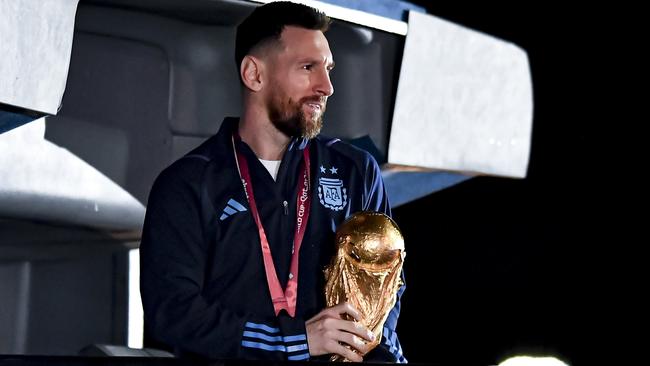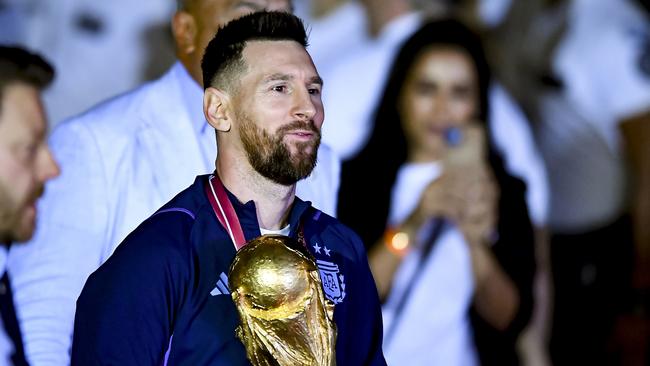Moments and names that made Imitation Games an event to remember
Henry Winter picks his best XI from the Qatar tournament in an event that resembled the Imitation Games.

At times, when Lionel Messi and Kylian Mbappe took control of the ball, and Morocco and Argentina fans took over souks and stadiums, Qatar 2022 felt like a real World Cup. At other times, the tournament lacked authenticity; a mirage in the desert, a glitzy caravan passing through a new town, stopping in temporary venues, choreographing audience behaviour with screams and shouts. This was the Imitation Games, given some legitimacy by a fabulous final.
A lot of the football was real and good, although more in bursts than non-stop action; a tournament of moments rather than sustained momentum, until that spectacular, seesaw final graced by Messi and Mbappe. It was not “the best World Cup ever” as the FIFA president, Gianni Infantino, bizarrely declared, surely for Qatari consumption rather than more attuned ears – though it was the best World Cup final ever, on reflection, a notch up on 1986.

It was not even the best World Cup of the 21st century – 2006 and 2014 were better – let alone rewinding back to the epics of 1970 and 1982. The World Cup belongs to the world, so let’s have it in places such as Morocco, where love for the game is deep and genuine, as seen out here. Why shouldn’t it go to Uruguay, Argentina, Paraguay and Chile in 2030, the centenary of the first tournament in Uruguay?
Why does it simply go to the wealthiest bidder? FIFA, of course. The cost of this World Cup in human life and moral values will for ever be a stain on FIFA.
But it banked a fortune, so it won’t worry.
FIFA turned this World Cup into the Imitation Games, the Political Games, as confirmed by giving an inexperienced Qatari referee the third-place play-off. So thank heavens for the excellent Polish official Szymon Marciniak, who handled the final expertly and, most importantly and thrillingly, the players.
Stepping into the world of subjectivity, here is my team of the tournament, laid out in 4-3-3 formation. In goal, just ahead of Emiliano Martinez, is Croatia’s Dominik Livakovic, who made three penalty saves to deny Japan in a round-of-16 shootout, then stopped Rodrygo’s penalty in the quarter-final shootout against Brazil, after making 10 saves in the game.
At right back, Achraf Hakimi encapsulated Morocco’s energy, while the centre back Josko Gvardiol, barring being Messied, was otherwise immense for Croatia. He partners Nicolas Otamendi, who was deemed a risk but did not put a foot wrong until a couple of ill-judged tackles in the final. Left back is tricky: Theo Hernandez was a possibility, but Argentina’s Marcos Acuna just shades it.
With respectful nods to Jude Bellingham, Luka Modric and Azzedine Ounahi, the midfield has to comprise Antoine Griezmann, who shone for France, whether closing down opponents or opening them up, Morocco’s all-action Sofyan Amrabat and Argentina’s young buck Enzo Fernandez.
Attack is simple: one star, Mbappe, and one superstar, Messi, are automatic choices, along with the tireless Julian Alvarez, edging out Olivier Giroud.
Of the young talents, Bellingham, Alvarez, Goncalo Ramos, Fernandez and Jamal Musiala all deserve praise, but the 20-year-old centre back Gvardiol was the best on view.
In a competition defined by moments, there have been some spectacular goals; Mbappe’s volley in the final; Richarlison’s flick and acrobatic finish for Brazil against Serbia; Salem Al-Dawsari dribbling and scoring in Saudi Arabia’s shock win over Argentina; Ramos’s stunning first for Portugal against Switzerland; and Wout Weghorst’s audacious set-piece equaliser for Holland against Argentina at such a key time. England deserve inclusion for that quick, incisive move involving John Stones, Harry Maguire, Luke Shaw, Phil Foden, Harry Kane and Bellingham for Jordan Henderson to score against Senegal.
Game of the tournament was Holland 2 Argentina 2, when the Dutch suddenly went all “Crazy Gang” and put the ball in the mixer, bringing Weghorst’s equaliser, then extra time, flare-ups, feuds and penalties. It was the game that had everything.
Coach of the tournament was Walid Regragui, who organised Morocco so well and generated so much team spirit, especially with the masterstroke of inviting players’ families into the hotel. His team reached the semi-finals, a historic achievement.
Many moments stand out: Martinez’s late save from Randal Kolo Muani in the final; that tackle by Gvardiol on Romelu Lukaku; Griezmann’s defending against Morocco in the second half, picking off Hakim Ziyech’s crosses; Mbappe embracing Hakimi; and the goosebumps moment of Morocco fans and players belting out their national anthem. And Iran’s brave players not singing theirs.
There was the lone Saltire, the flower of Scotland blooming in the desert, that kept popping up at games, even England’s. There was the thrilling sight of Bukayo Saka running at a terrified Hernandez, Declan Rice’s leadership, Kyle Walker standing up to Mbappe, and England fans getting their huge crowd-surfer with rainbow motif past FIFA checks and Qatari security.
VAR fared better in Russia in 2018. Some of the penalty decisions in Qatar seemed to favour the superstars, Messi and Cristiano Ronaldo. Morocco were horribly denied a clear penalty in their semi-final when Sofiane Boufal was fouled by Hernandez.
What was false, though, were some of the announcers screaming at fans at halftime to try to whip up an atmosphere. It’s so fake. Fair play to the England fans who refused to obey the instruction to hold up their phone lights. In fairness, one good innovation was a fan from each country reading out the line-ups pre-match; they know the pronunciations and treat each name as if it belonged to a beloved friend.
Away from the corporates corralled into lines like well-dressed, well-lunched school crocodiles, and match photographers instructed when to head to their “catwalk positions”, there were moments of authenticity. There was the hidden cafe in the Souk Waqif, off the main drag, down an alleyway, through an arch into what looks like someone’s garden. Then, please take a seat, don’t even attempt to order, just enjoy the array of delicacies – garlanded with humus and bonhomie.
One unexpected pleasure was meeting the one and only Chesney Hawkes, hearing about his life, love of West Ham United and fascinating musical heritage – his son a talented guitarist who tours with him, his father lead singer of the Tremeloes. After half an hour we went our separate ways, me to watch England training and Hawkes to go and sit on a camel in the desert for a photo shoot (eventually delayed as they couldn’t find a camel, in Qatar).
Finally, there was the unspeakable, tragic loss of our media colleagues Grant Wahl, Roger Pearce and Khalid al-Misslam. They will never be forgotten. RIP.
The Times



To join the conversation, please log in. Don't have an account? Register
Join the conversation, you are commenting as Logout